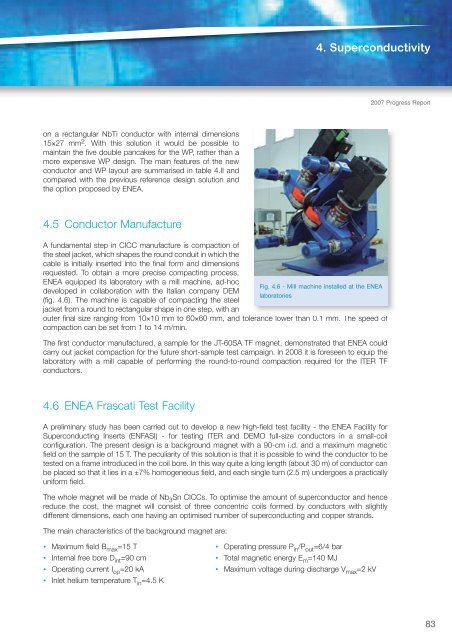Fusion Programme - ENEA - Fusione
Fusion Programme - ENEA - Fusione
Fusion Programme - ENEA - Fusione
- No tags were found...
Create successful ePaper yourself
Turn your PDF publications into a flip-book with our unique Google optimized e-Paper software.
4. Superconductivity2007 Progress Reporton a rectangular NbTi conductor with internal dimensions15×27 mm 2 . With this solution it would be possible tomaintain the five double pancakes for the WP, rather than amore expensive WP design. The main features of the newconductor and WP layout are summarised in table 4.II andcompared with the previous reference design solution andthe option proposed by <strong>ENEA</strong>.4.5 Conductor ManufactureA fundamental step in CICC manufacture is compaction ofthe steel jacket, which shapes the round conduit in which thecable is initially inserted into the final form and dimensionsrequested. To obtain a more precise compacting process,<strong>ENEA</strong> equipped its laboratory with a mill machine, ad-hocFig. 4.6 - Mill machine installed at the <strong>ENEA</strong>developed in collaboration with the Italian company DEMlaboratories(fig. 4.6). The machine is capable of compacting the steeljacket from a round to rectangular shape in one step, with anouter final size ranging from 10×10 mm to 60×60 mm, and tolerance lower than 0.1 mm. The speed ofcompaction can be set from 1 to 14 m/min.The first conductor manufactured, a sample for the JT-60SA TF magnet, demonstrated that <strong>ENEA</strong> couldcarry out jacket compaction for the future short-sample test campaign. In 2008 it is foreseen to equip thelaboratory with a mill capable of performing the round-to-round compaction required for the ITER TFconductors.4.6 <strong>ENEA</strong> Frascati Test FacilityA preliminary study has been carried out to develop a new high-field test facility - the <strong>ENEA</strong> Facility forSuperconducting Inserts (ENFASI) - for testing ITER and DEMO full-size conductors in a small-coilconfiguration. The present design is a background magnet with a 90-cm i.d. and a maximum magneticfield on the sample of 15 T. The peculiarity of this solution is that it is possible to wind the conductor to betested on a frame introduced in the coil bore. In this way quite a long length (about 30 m) of conductor canbe placed so that it lies in a ±7% homogeneous field, and each single turn (2.5 m) undergoes a practicallyuniform field.The whole magnet will be made of Nb 3 Sn CICCs. To optimise the amount of superconductor and hencereduce the cost, the magnet will consist of three concentric coils formed by conductors with slightlydifferent dimensions, each one having an optimised number of superconducting and copper strands.The main characteristics of the background magnet are:• Maximum field B max =15 T • Operating pressure P in /P out =6/4 bar• Internal free bore D int =90 cm • Total magnetic energy E m =140 MJ• Operating current I op =20 kA • Maximum voltage during discharge V max =2 kV• Inlet helium temperature T in =4.5 K83













